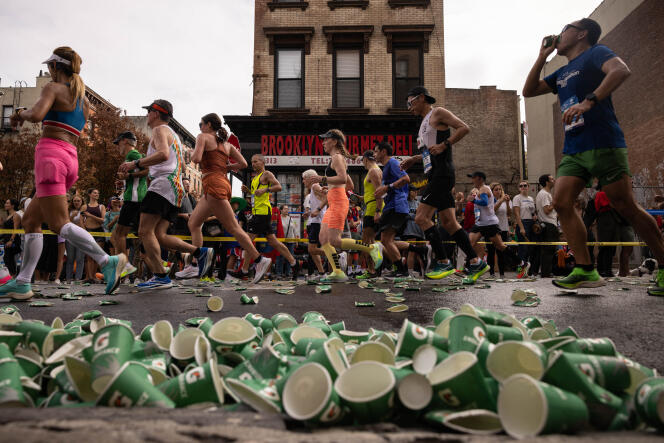VSn Sunday, November 5, New York City Marathon runners will start from the Verrazano-Narrows Bridge, which connects Staten Island to Brooklyn and which, since 1976, marks the start of a route that crosses the five boroughs from the city. This departure is an opportunity for spectacular aerial views.
Apart from the striking effect of the 50,000 participants on a suspension bridge, we understand that the camera would want to stay high during the marathon starts. The ground there is often disgusting: runners who start last are forced to watch their feet to avoid tripping over sweatshirts, trash bags thrown by those who started before them, energy gel wrappers, even bottles of urine rolling on the roadway. You read correctly.
In New York, the problems posed by poor planning of fluid consumption before a race are more acute than in other major marathons: the distant starting point requires being taken there several hours in advance, by ferry or by one of the three hundred buses in service for the occasion. From this first event of the day, it is not uncommon to hear participants begging to have access to a toilet as quickly as possible.
Garbage bags to relieve yourself
While the starting airlocks are distributed over the two heights of the suspension bridge, it has long been rumored that those who start from the lower deck run the risk of being sprayed by runners relieving themselves from the upper deck. Is it to silence the legend or to justify a 300 euro bib, the New York marathon has continued to increase the number of portable toilets installed at the start (more than 1,500 this year), while Dunkin’ Donuts, partner of the event, was responsible for distributing 50,000 coffees and 6,000 teas at the starting point to runners whose bladders were already out of breath.
There will always be participants refusing to use portable toilets so as not to lose strategic places in the starting gates. Some have already been seen putting on a pierced trash bag instead of their arms as a raincoat, and squatting down to relieve themselves in the starting airlock, surrounded by the runners on whose feet they have just urinated. So much so that the organizers had to specify in the regulations that “anyone seen urinating or defecating in a starting gate may be disqualified”.
Added to the problems of incontinence are those of clothing: the marathon takes place in November, participants often bring additional clothing to stay warm until the start of the race, which they get rid of at best when leaving, at worst in the first kilometers. Like most major marathons criticized for the pollution they cause, the one in New York has specified for years that discarded items are donated to charities.
You have 30% of this article left to read. The rest is reserved for subscribers.
